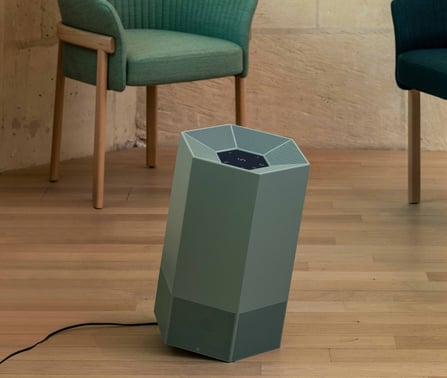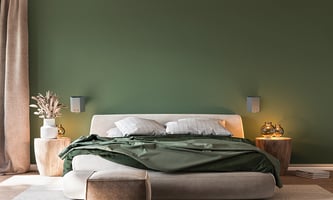Purifying the air in care homes

What good does air purification really do in a care home?
Financial benefits
Purifying the air in a care home reduces cross-contamination for the staff, resulting in a significant decrease in sick leave. The cost cutting that can be achieved by lowering absenteeism caused by poor air quality is estimated at around €450/employee/year*.
* Source: REHVA study
Health protection
Purifying the air in a care home protects the staff and residents against the risk of localised cross infections. But that’s not all.
Another benefit is a decrease in the risks associated with exposure to chemicals, for both staff and patients, which is a real health issue.
In fact, a GERIE study conducted at some 50 retirement homes located in seven European countries* has shown that indoor air in care homes has a direct effect on already fragile state of the lungs of elderly people. Even when a home adheres to European standards regarding the concentration of pollutants in the air, the end result is similar, so it is essential to purify the air in order to ensure that your establishment is able to offer a high quality of accommodation facilities.
* Belgium, Denmark, France, Greece, Italy, Poland and Sweden; study funded by the European Union
Enhanced comfort
Another advantage of purification is that clean, neutral air promotes social bonds by making visits to elderly people a more pleasant experience. By reducing the smell of urine, excrement and other unpleasant sources of odour that create suffocating atmospheres, you can improve the comfort of your indoor areas and boost the image of your establishment. There are also less direct benefits. For example, the air in care homes tends to be overheated, and purification can cool it and make it less suffocating. In addition, this solves the problem associated with recommendations that windows should be opened so as to freshen the air, which exposes the establishment to security issues and to the cold of winter.
Another advantage of purification is that clean, neutral air promotes social bonds by making visits to elderly people a more pleasant experience. By reducing the smell of urine, excrement and other unpleasant sources of odour that create suffocating atmospheres, you can improve the comfort of your indoor areas and boost the image of your establishment. There are also less direct benefits. For example, the air in care homes tends to be overheated, and purification can cool it and make it less suffocating. In addition, this solves the problem associated with recommendations that windows should be opened so as to freshen the air, which exposes the establishment to security issues and to the cold of winter.
Compliance with regulations
PNSE4
 Air purification also complies with PNSE4* by creating a healthy atmosphere for residents and visitors alike. Moreover, beginning on 1 January 2023, establishments in France that are open to people susceptible to disease will be required to monitor their indoor air quality. Care homes in particular will be subject to this new regulation. * France’s National Health and Environment Plan 4
Air purification also complies with PNSE4* by creating a healthy atmosphere for residents and visitors alike. Moreover, beginning on 1 January 2023, establishments in France that are open to people susceptible to disease will be required to monitor their indoor air quality. Care homes in particular will be subject to this new regulation. * France’s National Health and Environment Plan 4 French Decree 2015-1000
The riskiest times at care homes are when residents receive visitors or when at-risk residents attend gatherings. As a result, it is vital to evaluate the indoor air quality at your institution and satisfy the requirements of Decree 2015-1000, given the continuous presence of elderly people and the occasional presence of children under the age of 6.
What pollutants are found in the air in care homes?
 1- Contaminants
1- ContaminantsContaminants are perhaps the most problematic pollutants in care homes. The risk of spreading seasonal viruses (flu, etc.) and viruses like COVID-19 are vital issues to address in your environment, especially for your residents with weakened immune systems.
2- Odours
The daily activities at a care home cause many unpleasant odours, so their attendance can become problematic. The reality is that exposure to smells of excrement, body odour or the deceased is a major issue in terms of the staff’s working conditions. Not to mention the well-being of residents and visitors.
Within the family of odours, it should be noted that the various caregiving actions performed by personnel, such as the treatment of bedsores, changes of clothes and washing the residents, release many odorous pollutants into the air.
 3- Pollutants
3- Pollutants Although they are less central in this environment, cleaning and care products contain carcinogenic, cancer-causing VOCs (volatile organic compounds) that are dangerous for your health. Extended exposure to these substances can severely damage your respiratory system, as mentioned in the GERIE study.
In an urban setting, pollutants like PM10 and PM2.5 must be taken into consideration, as these pose a real threat to someone exposed to them over a medium to long term. In rural settings, agricultural pollutants (airborne pesticides and fertilisers) can also be dangerous to the health of residents and staff.
4- Allergens
Depending on your establishment’s design and location, allergens like pollens (if your facility has a park or gardens) and dust mites can also threaten the health of your susceptible or allergic residents and employees.
Benefits of the Shield range and key areas in care homes

• Treatment of odours in bedrooms and common areas
• Discreet presence
• Effective in a short time (< 20 mins)
• Ease of upkeep and user safety
• Discreet presence
• Effective in a short time (< 20 mins)
• Ease of upkeep and user safety
• Eco-friendly
• Plug and Play
• Easy to maintain: non-hazardous, with no consumables to replace
JVD’s Shield air purifiers can be placed in patients’ rooms as well as shared spaces like treatment rooms, physio areas, common areas, TV rooms, etc. They are also suitable for use in hallways and can create an improved atmosphere within your institution.




Laissez un commentaire